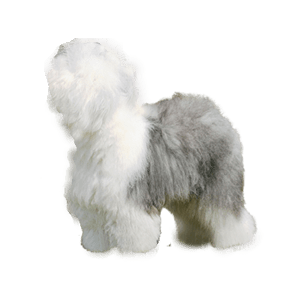Old English Sheepdog

“The Old English Sheepdog existed in the west of England, likely from the Bearded Collie or Russian Owtcharka. The breed was the solution to the need for a robust canine that helped protect the flocks and herds from the wolves that existed at one time in England. By the middle of the 19th century, those puppies were primarily used to drive farm animals and sheep to market.
As working puppies, they were exempt from canine taxes; however, their tails needed to be docked as evidence of their occupation. This custom endured in modern times and has brought about their nickname Bobtail.
The AKC identified the Old English in 1905. Popularity as a pet was slower to grow till the Seventies, when the breed became a favorite media animal. The breed’s reputation exploded with puppy owners looking for an amazing but adorable mop. Since then, the breed’s numbers have steadily declined, but the OES remains well-known. The Old English is now more frequently visible as a pet or shows canine than a working pet.”
- Type - Herding
- Weight -60-90 lb
- Height- 21-22"
- Family -Livestock, Herding
- Date of Orgin-1800s
- Area of Orgin -England
Energy Level
Exercise Requirements
Playfulness
Affection Level
Friendliness To Dogs
Friendliness To Other Pets
Friendliness To Strangers
Watchfulness
Ease of Training
Grooming Requirements
Heat Sensitivity
Vocality
Temperement
The amiable Old English is jolly, however gentle. The canine is a well-mannered residence puppy at home that frequently amuses the family with comical antics. The breed thrives on human companionship and is very much a homebody. Extremely committed to the family and defensive of family members, this canine will generally tend to kids as flock members and is usually friendly towards strangers. Some may be headstrong at training.
Upkeep
The Old English Sheepdog desires everyday exercise, both a mild to lengthy stroll or an energetic romp. The breed, of course especially enjoys herding. The coat desires brushing or combing every other day, or it could form mats.
Health
“Major diagnosis: CHD
Minor diagnosis: gastric torsion, otitis externa, retinal detachment, cataract, deafness, PRA, cerebellar ataxia, hypothyroidism
Occasionally seen: none
Suggested tests: hip, eye, thyroid, (hearing)
Life span: 10–12 years”
Disclaimer
Note: While the characteristics mentioned here may frequently represent this breed, dogs are individuals whose personalities and appearances will vary. Please consult the adoption organization for details on a specific pet.
